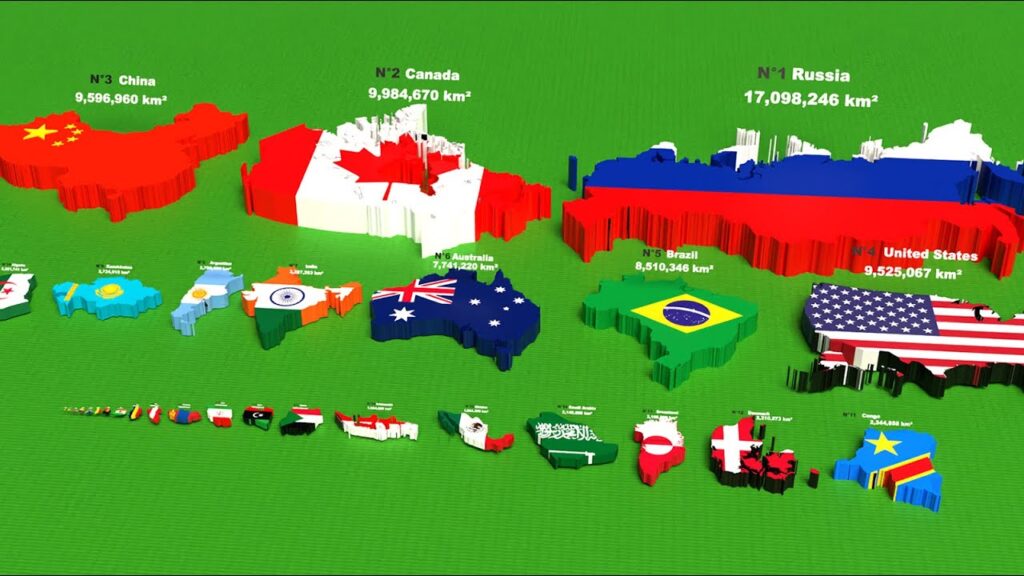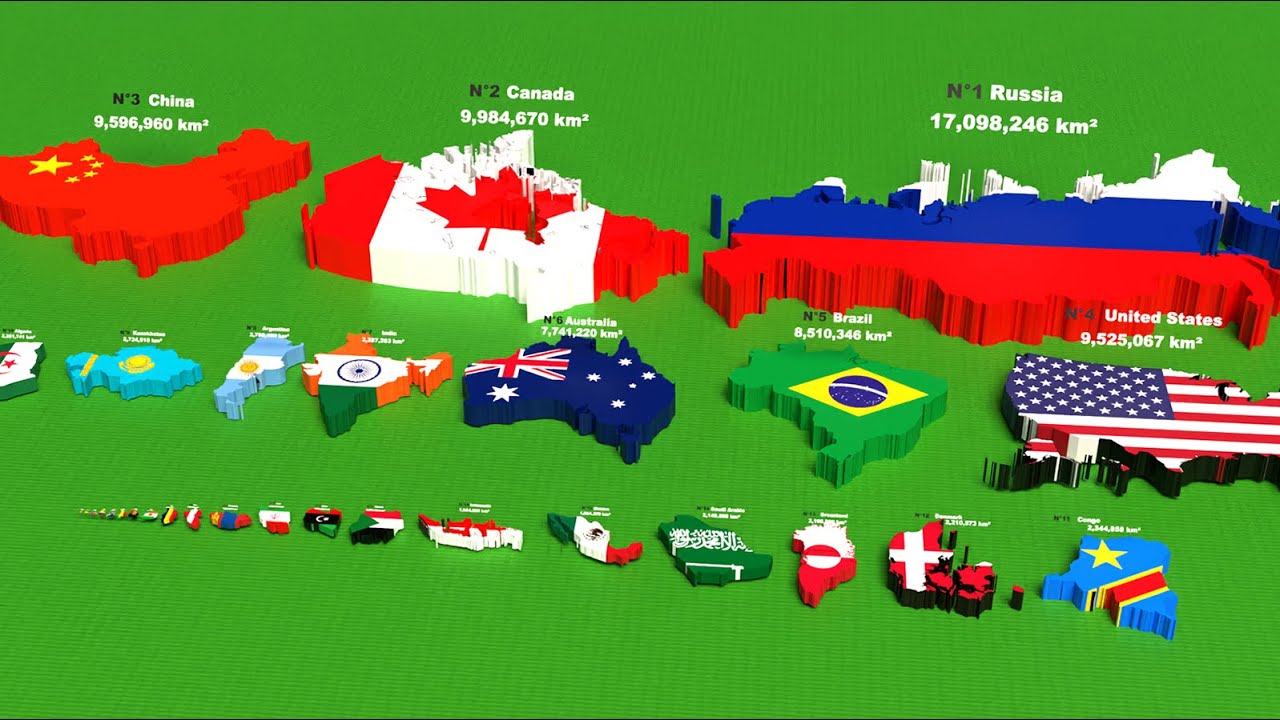Discover the world’s largest countries by land area. Explore fascinating facts, rankings, and geographical insights about these vast nations.
When we think about countries, we often consider their population, culture, economy, and history. However, one of the most fascinating aspects of a nation is its size. The land area of a country can significantly influence its resources, climate, biodiversity, and even its geopolitical significance. In this blog post, we will explore the world’s largest countries by land area, examining what makes each one unique and how their size impacts various aspects of life within their borders.
1. Russia: The Colossal Giant
Russia is the largest country in the world, spanning over 17.1 million square kilometers (6.6 million square miles). This vast expanse covers more than one-eighth of the Earth’s inhabited land area and stretches across Eastern Europe and northern Asia.
Geography and Climate
Russia’s geography is incredibly diverse, featuring tundra, forests, mountains, and plains. The Ural Mountains traditionally mark the boundary between Europe and Asia, while the Siberian region is known for its harsh climate, characterized by long winters and short summers. The country is home to Lake Baikal, the deepest freshwater lake in the world, and the Volga River, the longest river in Europe.
Cultural Diversity
With such a vast area, Russia is home to a multitude of ethnic groups and cultures. Over 190 ethnicities reside within its borders, each contributing to the rich tapestry of Russian culture. From the indigenous peoples of Siberia to the urban population of Moscow, the country’s diversity is a reflection of its expansive geography.
Economic Impact
Russia’s size also plays a crucial role in its economy. The country is rich in natural resources, including oil, natural gas, and minerals. These resources are vital for its economy and make Russia one of the world’s leading energy producers. However, the vast distances and harsh climates present challenges for infrastructure and transportation, impacting economic development in remote areas.
2. Canada: The Great White North
Canada is the second-largest country in the world, covering approximately 9.98 million square kilometers (3.85 million square miles). Known for its stunning landscapes and multicultural society, Canada is a country of contrasts.
Natural Wonders
Canada boasts an array of natural wonders, from the Rocky Mountains in the west to the vast boreal forests and tundra in the north. The country is home to numerous national parks, including Banff and Jasper, which attract millions of visitors each year. The Great Lakes, shared with the United States, are the largest group of freshwater lakes in the world, providing vital resources and recreational opportunities.
Cultural Mosaic
Canada is often described as a “cultural mosaic,” reflecting its commitment to multiculturalism. The country is home to a diverse population, with significant communities of Indigenous peoples, French Canadians, and immigrants from around the world. This diversity is celebrated through various festivals, cuisines, and artistic expressions.
Economic Strength
Canada’s economy is one of the largest in the world, driven by industries such as natural resources, manufacturing, and technology. The country’s size allows for significant agricultural production, particularly in the Prairie provinces. Additionally, Canada’s vast forests provide timber and other forest products, contributing to its economic strength.
3. China: The Giant of Asia
China ranks third in terms of land area, covering approximately 9.6 million square kilometers (3.7 million square miles). As the most populous country in the world, China’s size is not just a geographical statistic but a significant factor in its global influence.
Diverse Landscapes
China’s geography is incredibly varied, featuring mountains, plateaus, deserts, and rivers. The Himalayas, home to Mount Everest, form the southwestern border, while the Gobi Desert lies to the north. The Yangtze and Yellow Rivers are two of the most important rivers in the country, supporting agriculture and industry.
Cultural Heritage
China has a rich cultural heritage that spans thousands of years. It is home to one of the world’s oldest civilizations, with contributions to philosophy, art, science, and technology. The Great Wall, the Forbidden City, and the Terracotta Army are just a few examples of the country’s historical landmarks that attract tourists from around the globe.
Economic Powerhouse
China’s size contributes to its status as an economic powerhouse. The country has experienced rapid industrialization and urbanization over the past few decades, becoming the second-largest economy in the world. Its vast labor force and resources have made it a global manufacturing hub, while initiatives like the Belt and Road Initiative aim to expand its influence further.
4. United States: The Land of Opportunity
The United States is the fourth-largest country, covering about 9.83 million square kilometers (3.8 million square miles). Known for its cultural influence and economic power, the U.S. is a diverse nation with a wide range of landscapes.
Geographic Diversity
The U.S. features a variety of geographic regions, including mountains, plains, deserts, and coastlines. From the Rocky Mountains in the west to the Appalachian Mountains in the east, the country offers diverse climates and ecosystems. National parks like Yellowstone and the Grand Canyon showcase the natural beauty of the land.
Cultural Melting Pot
The U.S. is often referred to as a “melting pot” due to its diverse population. People from various backgrounds and cultures have contributed to the nation’s identity. Major cities like New York, Los Angeles, and Chicago are cultural hubs, offering a blend of food, art, and traditions from around the world.
Economic Influence
The U.S. has one of the largest and most technologically advanced economies in the world. Its size allows for significant agricultural production, particularly in the Midwest, while the technology sector in Silicon Valley drives innovation. The country’s economic strength is further enhanced by its natural resources, including oil, natural gas, and minerals.
5. Brazil: The Heart of South America
Brazil ranks fifth in land area, covering approximately 8.5 million square kilometers (3.3 million square miles). Known for its vibrant culture and biodiversity, Brazil is a country of immense natural beauty.
Ecological Richness
Brazil is home to the Amazon Rainforest, the largest tropical rainforest in the world, which plays a crucial role in regulating the Earth’s climate. The country’s diverse ecosystems include wetlands, savannas, and coastal regions, supporting a wide range of flora and fauna.
Cultural Vibrancy
Brazilian culture is a blend of Indigenous, African, and European influences, resulting in a rich tapestry of music, dance, and cuisine. Festivals like Carnival and Festa Junina showcase the country’s cultural diversity, attracting visitors from around the globe.
Economic Landscape
Brazil’s economy is the largest in South America, driven by agriculture, mining, and manufacturing. The country is a leading exporter of coffee, soybeans, and beef, making it a significant player in global markets. However, Brazil faces challenges such as economic inequality and environmental concerns related to deforestation.
6. Australia: The Island Continent
Australia, the sixth-largest country, covers about 7.7 million square kilometers (2.97 million square miles). Known for its unique wildlife and diverse landscapes, Australia is often referred to as the “island continent.”
Unique Geography
Australia features a range of geographic features, including deserts, rainforests, and coastal regions. The Outback, a vast arid interior, is home to unique wildlife and Indigenous cultures. The Great Barrier Reef, the world’s largest coral reef system, attracts tourists and researchers alike.
Indigenous Heritage
Australia has a rich Indigenous history that dates back thousands of years. Aboriginal and Torres Strait Islander peoples have a deep connection to the land, with cultural practices and traditions that continue to thrive today. Efforts to recognize and preserve Indigenous heritage are ongoing.
Economic Opportunities
Australia’s economy is diverse, with significant contributions from mining, agriculture, and services. The country is rich in natural resources, including coal, iron ore, and gold. Its strategic location in the Asia-Pacific region positions it as a key player in global trade.
Conclusion

The world’s largest countries by land area each have unique characteristics that shape their identity and influence. From Russia’s vastness to Brazil’s ecological richness, these nations offer a glimpse into the diverse landscapes, cultures, and economies that exist across the globe. Understanding the significance of land area not only highlights the geographical diversity of our planet but also underscores the interconnectedness of nations in an increasingly globalized world. As we explore these countries, we gain a deeper appreciation for the natural and cultural treasures they hold, reminding us of the importance of preserving and respecting our planet’s diversity for future generations.

